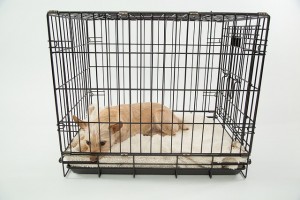My New Dog is Soiling the Crate. What Can I Do?
Dogs don’t naturally like to poop or urinate in the same place they live, eat and sleep. However, certain conditions may alter this nature and you’ll find a dog soiling his or her crate. Situations that may be responsible for this include:
A Health problem – A sick dog may not have the strength to walk out of the crate in order to get rid of waste.
Lack of attention – When you leave your dog in the crate for extended periods of time; she may not be able to hold herself and may end up soiling her crate.
Upbringing – If your dog grew up in an environment such as a high volume breeding or boarding facility where the space available doesn’t allow for a separate spot for peeing or pooping, they could lose their instinct to separate their living area from the toilet area. So, if your dog was adopted, you may find yourself in this situation.
If left unaddressed, crate soiling can become habitual. It is better to housebreak or crate train your dog while he or she’s still a puppy.
While the situation can be remedied, the time it takes would depend on how deeply ingrained the behavior has become.
Don’t punish your dog for soiling his or her crate as this could create anxiety and worsen the problem. Behavioral issues should always be handled with calmness, positive reinforcement and patience.
How to Stop Your Dog from Soiling His or Her Crate
Things required:
- A small room with easy-to-clean floors such as a bathroom or laundry room
- A small barrier or baby gate
- Old newspapers or piddle pads
- Your dog’s crate
- Water
- Toys and treats
Steps
- The barrier or gate should be placed in the doorway to prevent your dog from leaving the room. It should also be high enough to prevent him or her from jumping over.
- Spread the newspapers or puppy pads to cover the entire room.
- Place your dog’s crate in one area of the room leaving the door open together with his or her water bowl and toys. If your dog chooses to sleep in the crate and soils it, get it cleaned and change the bedding.
- As he or she begins to potty within a specific area of the room, gradually remove the newspapers or pads from the other areas. This stage should be carried out at a very slow pace. If you intend for your dog to potty within the house, you can go ahead and place the piddle pads or litter box in the area he or she frequents. If the plan was for your pet to potty outside, continue taking him or her to the designated area regularly ensuring that you encourage with commendation and treats.
- Once you notice a consistency in your dog’s potty habits inside or outside, you can remove the papers or pads from other parts of the room
- Re-introduce your dog to crate training gradually, leaving the door shut for short periods of time. If he or she soils the crate at any time, remove them from it to prevent continuation of the habit.
Since it is aimed at correcting a problem, these methods should complement rather than replace the basic housebreaking essentials such as:
- Ensuring that the crate or kennel is kept clean at all times
- Adhering to a regular feeding and potty schedule
- Having a designated area inside or outside the house where your dog potties
- Making sure you take your dog straight from the crate to the designated potty area when it’s time.
- Ensuring you make arrangement for potty trips if your dog would be alone for long periods.

